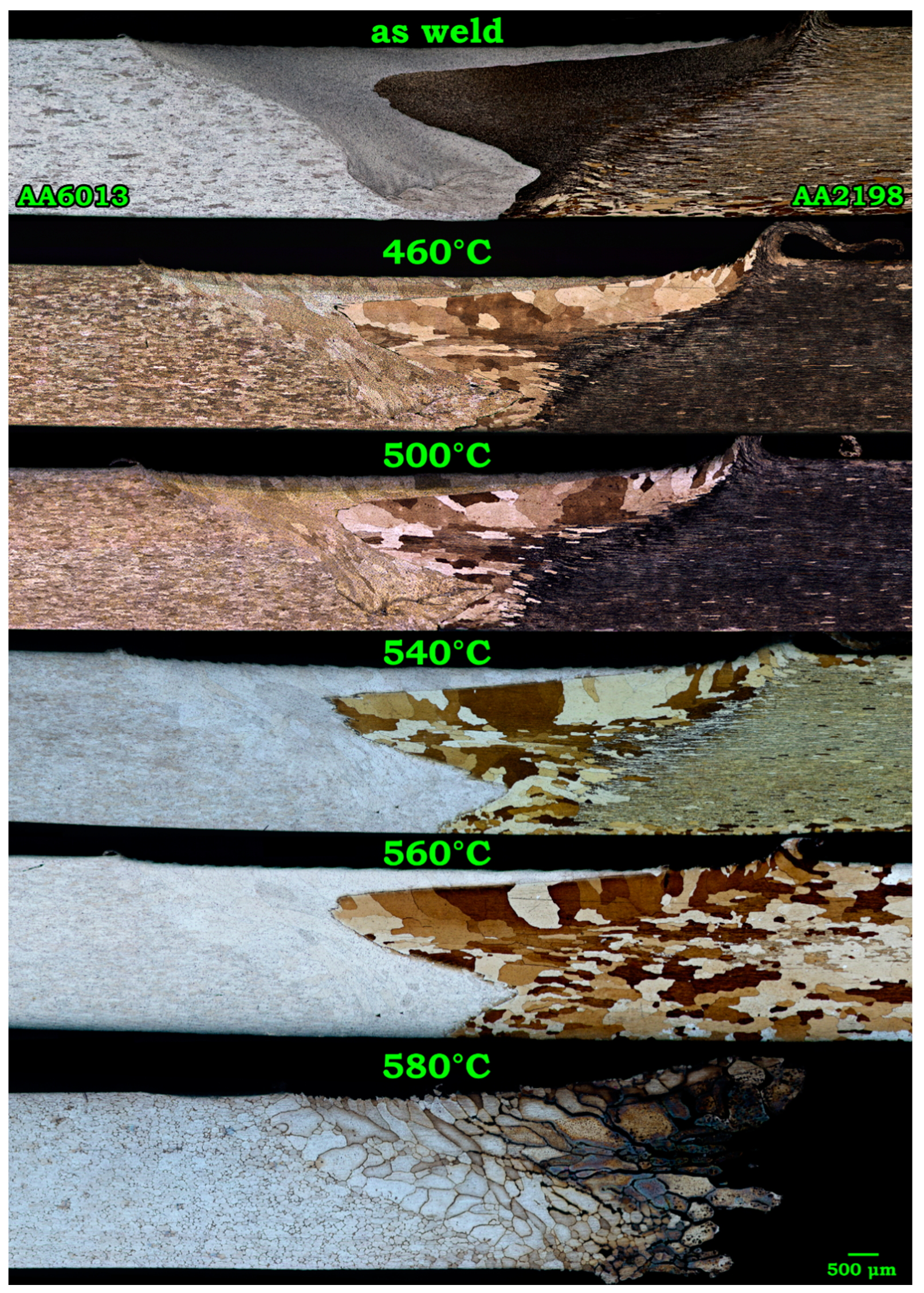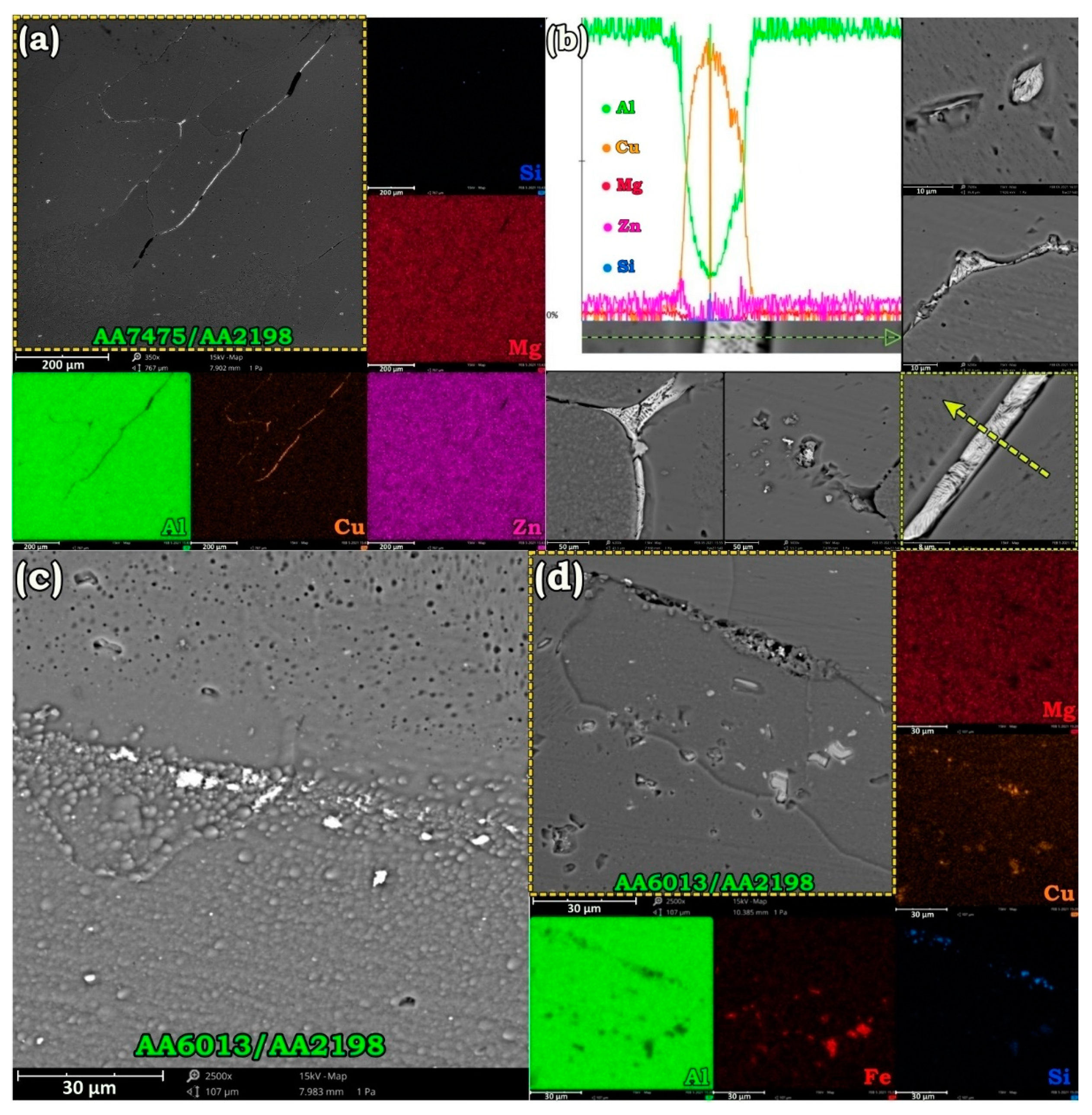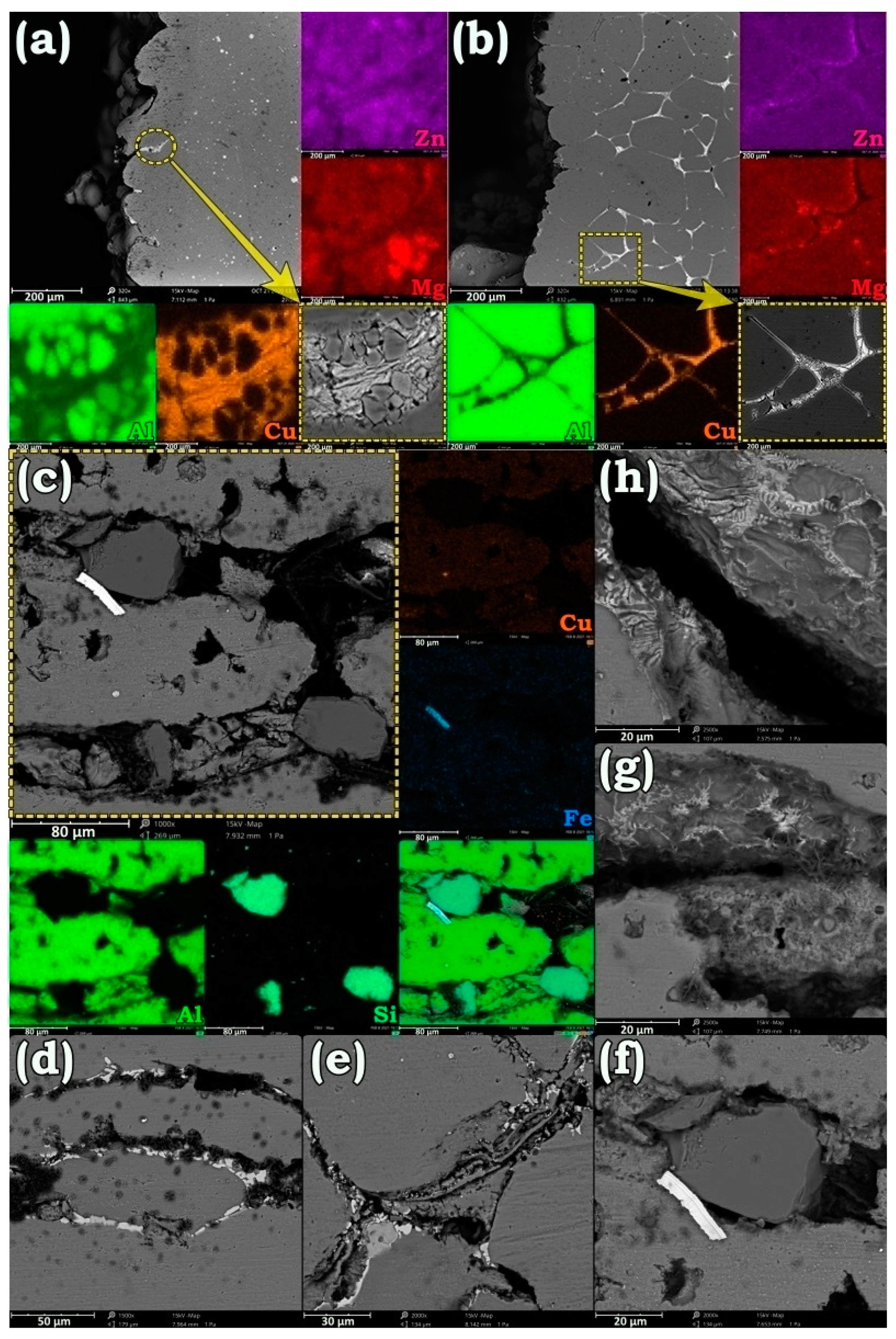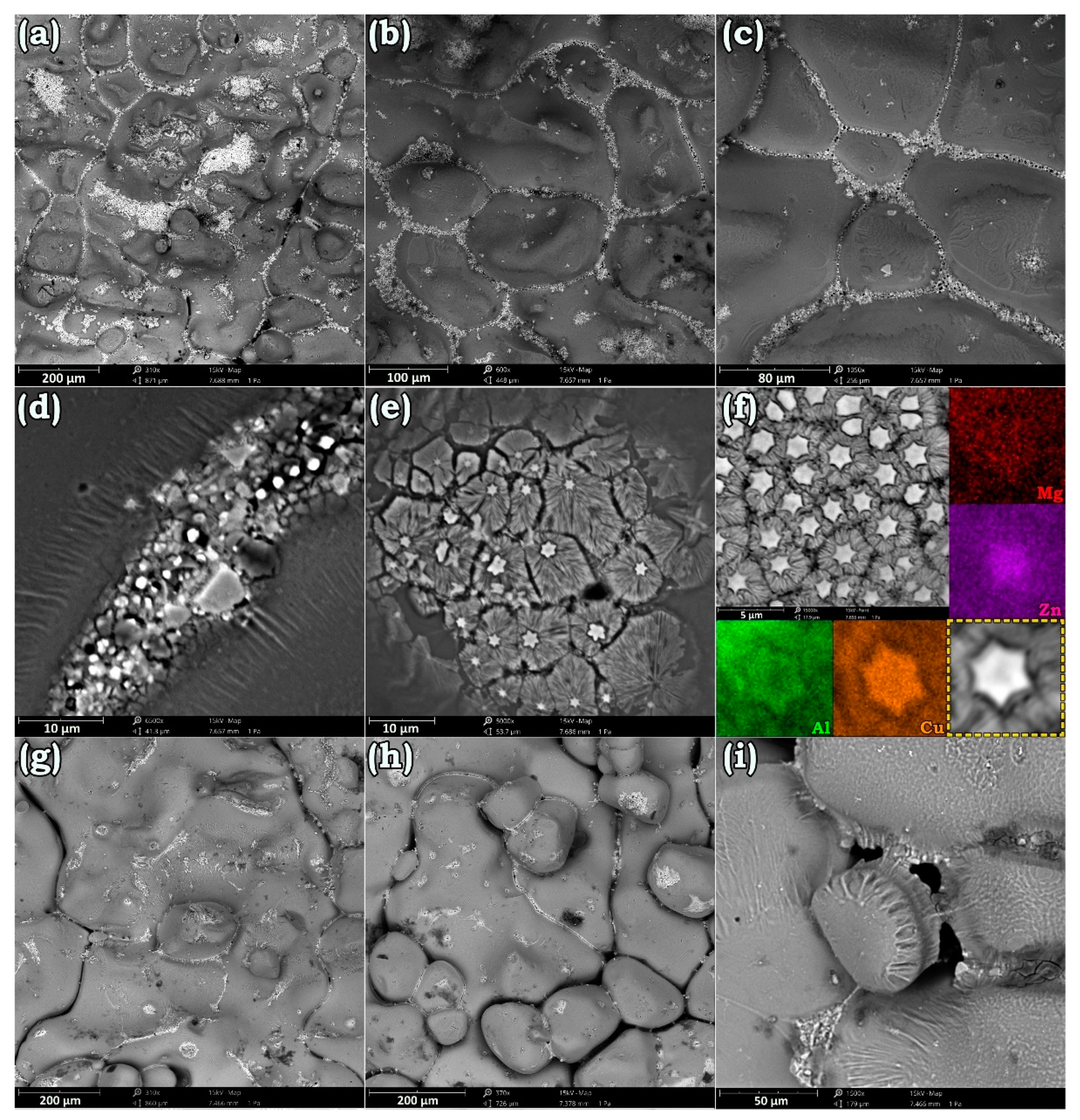Comparative Insight into the Interfacial Phase Evolutions during Solution Treatment of Dissimilar Friction Stir Welded AA2198-AA7475 and AA2198-AA6013 Aluminum Sheets
Abstract
1. Introduction
2. Materials and Methods
3. Results and Discussion
4. Conclusions
- By solutionizing, ultrafine grains were the initiation sites for abnormal grain growth within the SZ and experienced the maximum growth during treatment at elevated temperatures. Applying higher temperatures increased the growth rate of the grains and resulted in the disappearance of a higher fraction of fine grains at the expense of coarser ones.
- Treatment over 540 °C resulted in pre-melting/wetting of the GBs, and this accelerated the diffusion of the solute atoms to the GBs by the provision of the preferred migration channels. Consequently, for the AA2198-AA6013 specimens, Cu, Fe, and Si, and additionally in the AA2198-AA7475 joints, Cu, Zn, and Mg, migrated to the GBs. The diffusion of Cu to the GBs of AA2198 and AA7475 was accompanied by the formation of a Cu-rich eutectic phase, while in AA6013 this led to the formation of Cu-rich brittle particles. However, the diffusion of Mg and Zn in AA7475 and the diffusion of Si and Fe in AA6013 led to the formation of coarse polygonal particles at GBs, particularly at triple junctions.
- After air-cooling of solutionizing over 560 °C, the formation of a remarkable Cu-rich eutectic phase in the pre-melted zones, particularly in AA2198, resulted in intergranular failure due to solidification shrinkage. The formation of Mg and Zn particles at the weld interface of the AA7475-AA2198 joints and Si and Fe particles around the welding interface of the AA6013-AA2198 joints contributed to the failure of the weldments.
Author Contributions
Funding
Institutional Review Board Statement
Informed Consent Statement
Data Availability Statement
Conflicts of Interest
References
- Goel, P.; Mohd, A.W.; Sharma, N.; Siddiquee, A.N.; Khan, Z.A. Effects of Welding Parameters in Friction Stir Welding of Stainless Steel and Aluminum, Advances in Industrial and Production Engineering; Springer: Berlin/Heidelberg, Germany, 2019; pp. 815–823. [Google Scholar]
- Jandaghi, M.R.; Pouraliakbar, H. Elucidating the microscopic origin of electrochemical corrosion and electrical conductivity by lattice response to severe plastic deformation in Al-Mn-Si alloy. Mater. Res. Bull. 2018, 108, 195–206. [Google Scholar] [CrossRef]
- Kashaev, N.; Ventzke, V.; Çam, G. Prospects of laser beam welding and friction stir welding processes for aluminum airframe structural applications. J. Manuf. Process. 2018, 36, 571–600. [Google Scholar] [CrossRef]
- Çam, G.; Ipekoğlu, G. Recent developments in joining of aluminum alloys. Int. J. Adv. Manuf. Technol. 2017, 91, 1851–1866. [Google Scholar] [CrossRef]
- Guo, Y.; Ma, Y.; Wang, F. Dynamic fracture properties of 2024-T3 and 7075-T6 aluminum friction stir welded joints with different welding parameters. Theor. Appl. Fract. Mech. 2019, 104, 102372. [Google Scholar] [CrossRef]
- Zhu, H.; Dong, S.K.; Ma, Z.M.; Wang, J. Study on the Precipitation Behavior of Precipitates of 7075 Aluminum Alloy Friction Stir Welding Joint. Mater. Sci. Forum 2020, 1003, 37–46. [Google Scholar] [CrossRef]
- Çam, G.; Mistikoglu, S. Recent Developments in Friction Stir Welding of Al-alloys. J. Mater. Eng. Perform. 2014, 23, 1936–1953. [Google Scholar] [CrossRef]
- İpekoğlu, G.; Çam, G. Effects of Initial Temper Condition and Postweld Heat Treatment on the Properties of Dissimilar Fric-tion-Stir-Welded Joints between AA7075 and AA6061 Aluminum Alloys. In Metallurgical and Materials Transactions A; Springer: Berlin/Heidelberg, Germany, 2014; Volume 45. [Google Scholar]
- Singh, S.; Dhuria, G. Investigation of post weld cryogenic treatment on weld strength in friction stir welded dissimilar alu-minium alloys AA2014-T651 and AA7075-T651. In Materials Today: Proceedings; Elsevier: Amsterdam, The Netherlands, 2017; Volume 4, pp. 8866–8873. [Google Scholar]
- Tao, X.; Chang, Y.; Guo, Y.; Li, W.; Li, M. Microstructure and mechanical properties of friction stir welded oxide dispersion strengthened AA6063 aluminum matrix composites enhanced by post-weld heat treatment. Mater. Sci. Eng. A 2018, 725, 19–27. [Google Scholar] [CrossRef]
- Fu, R.-D.; Zhang, J.-F.; Li, Y.-J.; Kang, J.; Liu, H.-J.; Zhang, F.-C. Effect of welding heat input and post-welding natural aging on hardness of stir zone for friction stir-welded 2024-T3 aluminum alloy thin-sheet. Mater. Sci. Eng. A 2013, 559, 319–324. [Google Scholar] [CrossRef]
- Malopheyev, S.; Vysotskiy, I.; Kulitskiy, V.; Mironov, S.; Kaibyshev, R. Optimization of processing-microstructure-properties relationship in friction-stir welded 6061-T6 aluminum alloy. Mater. Sci. Eng. A 2016, 662, 136–143. [Google Scholar] [CrossRef]
- Khan, N.Z.; Siddiquee, A.N.; Khan, Z.A.; Shihab, S.K. Investigations on tunneling and kissing bond defects in FSW joints for dissimilar aluminum alloys. J. Alloys Compd. 2015, 648, 360–367. [Google Scholar] [CrossRef]
- Paidar, M.; Tahani, K.; Vignesh, R.V.; Ojo, O.; Ezatpour, H.; Moharrami, A. Modified friction stir clinching of 2024-T3 to 6061-T6 aluminium alloy: Effect of dwell time and precipitation-hardening heat treatment. Mater. Sci. Eng. A 2020, 791, 139734. [Google Scholar] [CrossRef]
- Khalilabad, M.M.; Zedan, Y.; Texier, D.; Jahazi, M.; Bocher, P. Effect of tool geometry and welding speed on mechanical prop-erties of dissimilar AA2198–AA2024 FSWed joint. J. Manuf. Process. 2018, 34, 86–95. [Google Scholar] [CrossRef]
- Pouraliakbar, H.; Khalaj, G.; Jandaghi, M.R.; Fadaei, A.; Ghareh-Shiran, M.K.; Shim, S.H.; Hong, S.I. Three-layered SS321/AA1050/AA5083 explosive welds: Effect of PWHT on the interface evolution and its mechanical strength. Int. J. Press. Vessel. Pip. 2020, 188, 104216. [Google Scholar] [CrossRef]
- Khalaj, G.; Pouraliakbar, H.; Jandaghi, M.R.; Gholami, A. Microalloyed steel welds by HF-ERW technique: Novel PWHT cycles, microstructure evolution and mechanical properties enhancement. Int. J. Press. Vessel. Pip. 2017, 152, 15–26. [Google Scholar] [CrossRef]
- Wang, J.; Fu, R.; Li, Y.; Zhang, J. Effects of deep cryogenic treatment and low-temperature aging on the mechanical properties of friction-stir-welded joints of 2024-T351 aluminum alloy. Mater. Sci. Eng. A 2014, 609, 147–153. [Google Scholar] [CrossRef]
- Widener, C.A. Evaluation of post-weld heat treatments for corrosion protection in friction stir welded 2024 and 7075 alumi-num alloys. Ph.D. Thesis, Wichita State University, Wichita, KS, USA, December 2005. [Google Scholar]
- İpekoğlu, G.; Erim, S.; Çam, G. Effects of temper condition and post weld heat treatment on the microstructure and mechani-cal properties of friction stir butt-welded AA7075 Al alloy plates. Int. J. Adv. Manuf. Technol. 2014, 70, 201–213. [Google Scholar] [CrossRef]
- Badini, C.; Pavese, M.; Fino, P.; Biamino, S. Laser beam welding of dissimilar aluminium alloys of 2000 and 7000 series: Effect of post-welding thermal treatments on T joint strength. Sci. Technol. Weld. Join. 2009, 14, 484–492. [Google Scholar] [CrossRef]
- Zhang, C.; Huang, G.; Zhang, D.; Sun, Z.; Liu, Q. Microstructure and mechanical properties in dissimilar friction stir welded AA2024/7075 joints at high heat input: Effect of post-weld heat treatment. J. Mater. Res. Technol. 2020, 9, 14771–14782. [Google Scholar] [CrossRef]
- Cerri, E.; Leo, P. Mechanical properties evolution during post-welding-heat treatments of double-lap Friction Stir Welded joints. Mater. Des. 2011, 32, 3465–3475. [Google Scholar] [CrossRef]
- Huang, Y.X.; Wan, L.; Lv, Z.L.; Lv, S.X.; Zhou, L.; Feng, J.C. Microstructure and microhardness of aluminium alloy friction stir welds with heat treatment. Sci. Technol. Weld. Join. 2016, 21, 1–7. [Google Scholar] [CrossRef]
- Bugarin, A.; De Abreu, C.; Terada, M.; De Melo, H.; Costa, I. Effect of friction stir welding (FSW) on the electrochemical behav-ior and galvanic coupling of AA2024-T3 and AA7475-T651. Mater. Today Commun. 2020, 25, 101591. [Google Scholar] [CrossRef]
- Khan, N.Z.; Ubaid, M.; Siddiquee, A.N.; Khan, Z.A.; Al-Ahmari, A.; Chen, X.; Abidi, M.H. Microstructural features of friction stir welded dissimilar Aluminium alloys AA2219-AA. Mater. Res. Express 2018, 5, 056531. [Google Scholar] [CrossRef]
- Niu, P.; Li, W.; Li, N.; Xu, Y.; Chen, D. Exfoliation corrosion of friction stir welded dissimilar 2024-to-7075 aluminum alloys. Mater. Charact. 2019, 147, 93–100. [Google Scholar] [CrossRef]
- Zhang, C.; Huang, G.; Cao, Y.; Zhu, Y.; Liu, Q. On the microstructure and mechanical properties of similar and dissimilar AA7075 and AA2024 friction stir welding joints: Effect of rotational speed. J. Manuf. Process. 2019, 37, 470–487. [Google Scholar] [CrossRef]
- Delijaicov, S.; Rodrigues, M.; Farias, A.; Neves, M.D.; Bortolussi, R.; Miyazaki, M.; Brandão, F. Microhardness and residual stress of dissimilar and thick aluminum plates AA7181-T7651 and AA7475-T7351 using bobbin, top, bottom, and double-sided FSW methods. Int. J. Adv. Manuf. Technol. 2020, 108, 277–287. [Google Scholar] [CrossRef]
- Patta, V.; Reddy, G.; Rao, K. Microstructure, mechanical and corrosion behavior of high strength AA7075 aluminium alloy friction stir welds e Effect of post weld heat treatment. Def. Technol. 2015, 11, 362–369. [Google Scholar]
- Sullivan, A.; Kamp, N.; Robson, J.D. Microstructural Evolution in AA7449 Plate Subject to Friction Stir Welding and Post Weld Heat Treatment. Mater. Sci. Forum 2006, 519–521, 1181–1186. [Google Scholar] [CrossRef]
- Pabandi, H.K.; Jashnani, H.R.; Paidar, M. Effect of precipitation hardening heat treatment on mechanical and microstructure features of dissimilar friction stir welded AA2024-T6 and AA6061-T6 alloys. J. Manuf. Process. 2018, 31, 214–220. [Google Scholar] [CrossRef]
- Moradi, M.M.; Aval, H.J.; Jamaati, R. Effect of pre and post welding heat treatment in SiC-fortified dissimilar AA6061-AA2024 FSW butt joint. J. Manuf. Process. 2017, 30, 97–105. [Google Scholar] [CrossRef]
- Nelson, T.; Steel, R.; Arbegast, W. In situ thermal studies and post-weld mechanical properties of friction stir welds in age hardenable aluminium alloys. Sci. Technol. Weld. Join. 2003, 8, 283–288. [Google Scholar] [CrossRef]
- Safarbali, B.; Shamanian, M.; Eslami, A. Effect of post-weld heat treatment on joint properties of dissimilar friction stir welded 2024-T4 and 7075-T6 aluminum alloys. Trans. Nonferrous Met. Soc. China 2018, 28, 1287–1297. [Google Scholar] [CrossRef]
- Paidar, M.; Vignesh, R.V.; Khorram, A.; Ojo, O.O.; Rasoulpouraghdam, A.; Pustokhina, I. Dissimilar modified friction stir clinching of AA2024-AA6061 aluminum alloys: Effects of materials positioning. J. Mater. Res. Technol. 2020, 9, 6037–6047. [Google Scholar] [CrossRef]
- Jandaghi, M.R.; Pouraliakbar, H.; Hong, S.I.; Pavese, M. Grain boundary transition associated intergranular failure analysis at TMAZ/SZ interface of dissimilar AA7475-AA2198 joints by friction stir welding. Mater. Lett. 2020, 280, 128557. [Google Scholar] [CrossRef]
- İpekoğlu, G.; Kıral, B.G.; Erim, S.; Çam, G. Investigation of the effect of temper condition on friction stir weldability of AA7075 Al-alloy plates. Mater. Technol. 2012, 46, 627–632. [Google Scholar]
- Straumal, B.; Kogtenkova, O.; Zięba, P. Wetting transition of grain-boundary triple junctions. Acta Mater. 2008, 56, 925–933. [Google Scholar] [CrossRef]
- Rabkin, E.; Shvindlerman, L.; Straumal, B. Grain boundaries: Phase transitions and critical phenomena. Int. J. Mod. Phys. B 1991, 5, 2989–3028. [Google Scholar] [CrossRef]
- Jandaghi, M.; Badini, C.; Pavese, M. Dissimilar friction stir welding of AA2198 and AA7475: Effect of solution treatment and aging on the microstructure and mechanical strength. J. Manuf. Process. 2020, 57, 712–724. [Google Scholar] [CrossRef]
- Zobac, O.; Kroupa, A.; Zemanova, A.; Richter, K.W. Experimental Description of the Al-Cu Binary Phase Diagram. Metall. Mater. Trans. A 2019, 50, 3805–3815. [Google Scholar] [CrossRef]









| Alloy | Al | Cu | Mg | Zn | Si | Fe |
|---|---|---|---|---|---|---|
| AA2198 | 96.27 | 3.03 | 0.70 | - | - | - |
| AA7475 | 90.45 | 1.47 | 3.35 | 4.74 | - | - |
| AA6013 | 96.87 | 1.00 | 1.81 | - | 0.24 | 0.09 |
Publisher’s Note: MDPI stays neutral with regard to jurisdictional claims in published maps and institutional affiliations. |
© 2021 by the authors. Licensee MDPI, Basel, Switzerland. This article is an open access article distributed under the terms and conditions of the Creative Commons Attribution (CC BY) license (http://creativecommons.org/licenses/by/4.0/).
Share and Cite
Jandaghi, M.R.; Pouraliakbar, H.; Saboori, A.; Hong, S.I.; Pavese, M. Comparative Insight into the Interfacial Phase Evolutions during Solution Treatment of Dissimilar Friction Stir Welded AA2198-AA7475 and AA2198-AA6013 Aluminum Sheets. Materials 2021, 14, 1290. https://doi.org/10.3390/ma14051290
Jandaghi MR, Pouraliakbar H, Saboori A, Hong SI, Pavese M. Comparative Insight into the Interfacial Phase Evolutions during Solution Treatment of Dissimilar Friction Stir Welded AA2198-AA7475 and AA2198-AA6013 Aluminum Sheets. Materials. 2021; 14(5):1290. https://doi.org/10.3390/ma14051290
Chicago/Turabian StyleJandaghi, Mohammad Reza, Hesam Pouraliakbar, Abdollah Saboori, Sun Ig Hong, and Matteo Pavese. 2021. "Comparative Insight into the Interfacial Phase Evolutions during Solution Treatment of Dissimilar Friction Stir Welded AA2198-AA7475 and AA2198-AA6013 Aluminum Sheets" Materials 14, no. 5: 1290. https://doi.org/10.3390/ma14051290
APA StyleJandaghi, M. R., Pouraliakbar, H., Saboori, A., Hong, S. I., & Pavese, M. (2021). Comparative Insight into the Interfacial Phase Evolutions during Solution Treatment of Dissimilar Friction Stir Welded AA2198-AA7475 and AA2198-AA6013 Aluminum Sheets. Materials, 14(5), 1290. https://doi.org/10.3390/ma14051290









